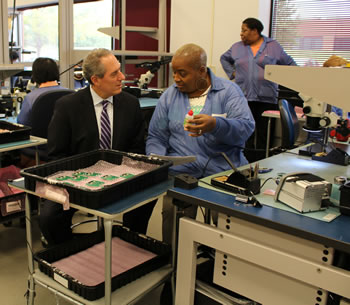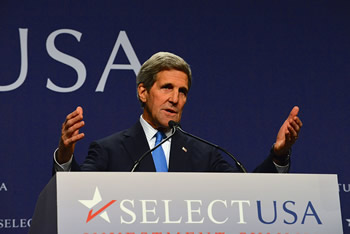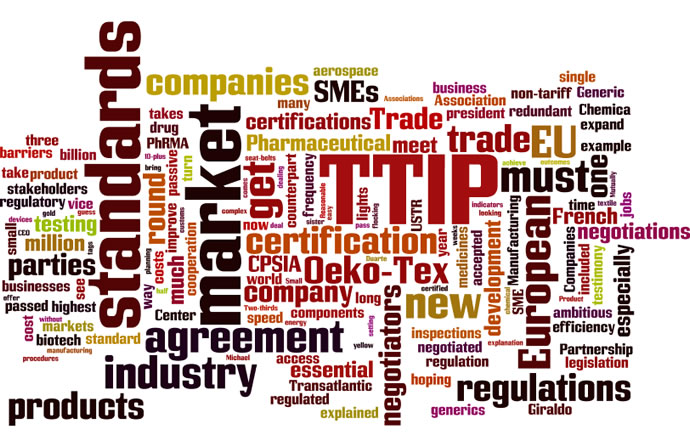This commentary is the third installment of a three-part series.
Once finalized, the Transatlantic Trade and Investment Partnership (TTIP) treaty will be the most ambitious trade agreement ever negotiated. The stakes are incredibly high, with much to be gained for parties in both the United States and the European Union, especially for small to medium sized enterprises (SMEs) in all industries looking to expand.
According to figures from the office of the US Trade Representative (USTR), more than 20 million companies in the EU and 28 million in the US qualify as SMEs. Two-thirds of all private-sector jobs in the EU are created by SMEs, while small businesses provide over half of all jobs in the US. These companies produce about 30 percent of goods from both markets. The removal of non-tariff barriers — standardization of certifications or removing redundant or burdensome regulations — would go a long way toward helping SMEs expand their businesses.
When French Chemicals Met US Textiles
The chemical industry is highly regulated. Companies planning to enter a new market must comply with a host of standards. In textile flocking, for instance, complex certifications which test the components contained in the printing material must be obtained. In the US, certifications mandated by the Consumer Product Safety Improvement Act (CPSIA) are considered the gold standard.
Chemica is a French company that manufactures heat transfer films for textiles. Though the company is now well established in the North American market, it was not an easy ride. Their products are certified by the Oeko-Tex Standard 100, a Swiss certification that is one of the highest safety standards in Europe.
“Even though the Oeko-Tex standards are similar to the CPSIA requirements, our products had to take the test all over again with CPSIA-approved laboratories,” says Gabriel Giraldo, vice president of sales and marketing of Chemica US Corp.
Just as frustrating, the Oeko-Tex certification is accepted in the US for some components but not for others. Oeko-Tex certification has been accepted for lead control by the CPSIA since 2009, but when it comes to phthalate levels — even with the exact same standards — the Oeko-Tex certification is not enough to market the product in the US. Relieving such redundancy in certification is one of the outcomes a successful TTIP would achieve.
Manufacturing a Compatible Ride
Under the current regulations, forget about driving a US-tested automobile in the streets of Paris. Europe’s automotive regulation requires cars to have orange, amber or yellow turn signal lights in order to differentiate them from brake lights. On the other hand, the US allows rear turn indicators to be red. That’s just one among many examples of regulatory divergence in automotive regulations, piling on compatibility costs for exports; such items as brakes, seat-belts, electric windows and door-locks must be specifically adjusted to meet each party’s standards.

Industrial regulation harmonization with the highest standards is essential when creating global markets. For example, passive radio frequency identification (RFID) tags used in the aerospace industry are one of a select group of products regulated worldwide by a single standard. Companies in the EU, the US or anywhere in the world meet the same required standards and can export to any market. And that’s great, until other obstacles get in the way of business.
Alexis Beurdeley is the vice president of MAINtag, Inc., a French company and a European leader in manufacturing passive RFID for the aerospace industry. He says one of his company’s biggest challenges when importing a new product is dealing with US customs. Products are often held up, sometimes up to three weeks, without rhyme, reason or explanation.
Some standards, like electricity infrastructure, cannot be changed for obvious reasons. Edmundo Duarte, CEO of EU Power Management Systems (EUPMS), explained that his company provides power management devices and services to improve energy efficiency. The products are manufactured in France but must be customized for the US market, to be compatible with the US voltage and frequency. But for many other standards and regulations, an ambitious TTIP could — and should — promote a comprehensive mutual recognition for industrial standards.

Where TTIP Stands
The most recent round of TTIP negotiations took place in Brussels, Belgium, February 2-6, 2015, under the leadership of USTR Ambassador Michael Froman and EU Trade Commissioner Cecilia Malmström. This marked the eighth round of negotiations and included, as previous rounds did, opportunities for stakeholders to hear from the negotiators and offer feedback and testimony. Discussion topics included critical issues of regulatory cooperation and market access. The next round of negotiations is scheduled for April 20 -24 in Washington, D.C.
2015 marks a pivotal year for TTIP. It is essential that Congress pass Trade Protection Agreement legislation that will limit that body to an up or down vote on TTIP. Without such legislation, this vital agreement will never see the light of day. Some observers say TPA must be passed in 2015 before the politics of the 2016 election cycle take over.
While officials still say they are hoping to have a TTIP agreement completed by 2015, Joseph P. Quinlan, senior fellow at the Center for Transatlantic Relations at Johns Hopkins University, told European news site, Euractiv.com, he does not expect to see an agreement this year. “Nevertheless,” he said, “I’m hoping that the trade negotiators keep working hard, covering as much ground as possible in 2015. I do think this continues on into 2016, 2017 until we get the deal that both parties want and [that] is beneficial to all stakeholders.”
Reasonable Regulation
$2.6 billion, 10-plus years.
That’s how much it costs and how long it takes to develop a prescription drug and bring it to market in the US, according to a 2014 report by the Tufts Center for the Study of Drug Development. The same study determined that an additional $312 million is invested on post-approval development — studies testing new applications or dosages, for example — bringing the total development cost to $2.9 billion.
“A well-constructed TTIP could open up vast new possibilities for cooperation and collaboration that would improve market access and speed the development and approval processes for new medicines,” wrote Jay Taylor of the Pharmaceutical Research and Manufacturers of America (PhRMA), an industry association made up of researchers and biotech companies. This would be especially true of SMEs in the biopharma sectors struggling to compete in a capital-intensive industry.
PhRMA, along with its sister organization in the EU, the European Federation of Pharmaceutical Industries and Associations (EFPIA), testified before TTIP negotiators during the fifth round of talks in 2014 on behalf of their members. Other industry associations, including the Biotechnology Industry Organization (BIO), the Generic Pharmaceutical Association (GPhA) and its European counterpart the European Generic medicines Association (EGA), weighed in with testimony as well.
Among the chief concerns for biotech companies are:
- Streamline regulations — lowering the cost and time of getting new drugs/devices to market by increasing efficiency and expediting drug review;
- Create a single development/approval pathway for generics — reducing the time it takes for generics to get to market at substantial savings for SME manufacturers;
- Mutually recognize Good Manufacturing Practice inspections – by reducing redundant testing and inspections, resources are put to better use.
Living Up to the Hype and Hope
It’s anyone’s guess whether TTIP negotiators will be able to craft an agreement that can meet the expectations of all the interested parties, especially those SME’s eager to enhance their transatlantic business. We do know this: TTIP and its Asian counterpart the Trans-Pacific Partnership (TPP), currently being negotiated between the US and of its 13 trade partners, are setting the tone for the future of world trade. It is essential to get it right, to get it fair and to get it now.
hosted Feb. 26 at Emory University in Atlanta
by the American Chamber of Commerce in Germany


March 23-24, Prince George’s County, Md


